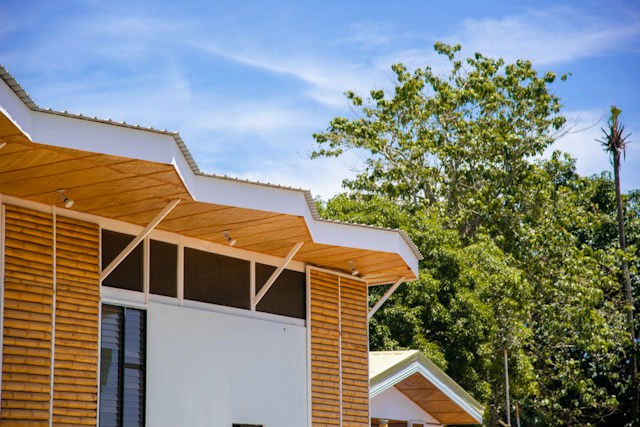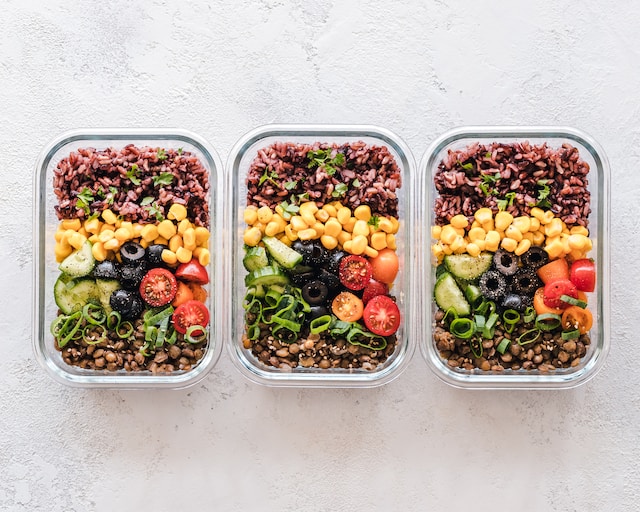In a world where everyone’s talking about going green, sustainable living is the buzzword, but we aren’t talking lofty ideals here—just real tips from the experts on how bamboo can shake up your home decor and building choices.
Building with Bamboo
Bamboo’s strength, coupled with its flexibility, makes it an excellent choice for various construction applications. Beyond its structural benefits, bamboo resists pests and fungi, ensuring longevity without compromising environmental considerations. Whether crafting fencing, flooring, or entire structures, bamboo brings a unique blend of durability and sustainability to your home.
What are some benefits of using eco-friendly building materials such as bamboo?
Using bamboo as an alternative building material can have several benefits compared to conventional materials – some are relatively familiar, others are less obvious.
Renewable resource: Bamboo is a rapidly renewable resource that can grow to maturity within 3-5 years, making it a sustainable alternative to traditional timber, which takes decades to grow.
Additionally, bamboo can grow in almost any climate and requires little water and no pesticides or fertilizers.
More eco-friendly: The cement and steel industries are among the most polluting on our planet, contributing to 13.5% of global CO2 emissions.
While the production and treatment of bamboo building materials also releases CO2, during the growing phase, bamboo removes CO2 from the air, making it a net CO2 reducer.
Studies show that using bamboo as a construction material can significantly lower CO2 emissions – even more so than timber.
Strength: Bamboo has a compressive strength 10% higher than wood and about the same tensile strength. Moreover, bamboo’s tensile strength is 3 to 4 times higher than steel’s per unit of weight.
Cost-Effectiveness: Studies show that the strength-cost-effectiveness of bamboo is 9 times better than that of Steel. Even compared to wood, bamboo is often more affordable, especially in regions where it is locally abundant. Its rapid growth also means a quick turnover for farmers, leading to economic benefits.
Versatility: Bamboo isn’t just a viable alternative to steel-reinforced concrete or wood like most people think. For instance, bamboo can also be used to create furniture, roofing, fences, scaffolding, and flooring. Moreover, bamboo can even replace plastic, for example, in drainage and pipe systems due to its natural hollow structure.
Reduction in Deforestation: Using bamboo instead of hardwood or other slow-growing trees decreases the demand for traditional timber, leading to reduced pressure on forests and helping to address the growing issue of deforestation.
-Florian Springer at Citizen Sustainable
How is bamboo used as a building material, and what are its advantages over traditional materials?
To understand the many uses of Bamboo, we must understand the development of its microstructure over the years. In its first year, the bamboo culm is full of starch and has very little fibres. At this stage, it is food that many animals and humans like to eat. As the bamboo culm grows older, the density of fibers increases, and the starch content decreases. It can be used for weaving baskets and other applications at that stage. Only after about 4 years of age, it becomes viable for construction.
At that time, bamboo presents a natural tube that has a higher tensile strength than steel but is at the same time much lighter. Additionally, it is a reinforced tube because of its nodes. Some species present as rods with almost no hole in the middle, making them dense bundles of fibres. These different forms have different applications. While tubes are structurally very strong as they are resistant to bending or breaking and are well equipped to take heavy loads, rods are more flexible, and because of their high density of fibers, their tensile strength is superior to most other construction materials including steel.
In our practice, we use bamboo as a structural element. We like to bundle rods and create trusses or arches that can span vast distances and create open spaces without columns in the middle. Similar to steel trusses. In our way of looking at bamboo, it can replace steel in most applications. As structural parts of buildings are usually well protected from sun and rain, bamboo can outlast steel as well, and it doesn’t rust. Additionally, because the bamboo arches, trusses, and weavings are attractive to look at, we don’t need to cover it up, paint it or put in a ceiling. Thus, we can create beautiful and functional spaces that are highly sustainable as bamboo is the only construction material that is carbon negative as it binds carbon during its growth.
-Markus Roselieb at Chiangmai Life Architects
How does bamboo flooring contribute to sustainability, and what should I consider when selecting it?
If sustainability is a factor in making your purchases, then bamboo should be one of the top choices when considering your next flooring project. Most bamboo flooring products available in the United States are made from Moso bamboo. Moso bamboo is one of the “giant” bamboo species and has been the cornerstone of bamboo building products to date.
Because of its fast growth, bamboo is managed as an agricultural crop. The bamboo is harvested every 4-5 years. This creates a steady stream of bamboo without disruptions and means no deforestation occurs. Comparable hardwood species take 60-80 years to grow to maturity before being cut down.
Bamboo is a bio-based material and acts as a CO2 sink. The bamboo plants absorb the Carbon Dioxide (CO2) and convert it into glucose and oxygen. The CO2 is stored in the material for the life of the product. The amount of CO2 locked in the product can be calculated quite simply by taking the density of the material and taking into account the amount of bio-based material.
Recent advancements in bamboo technology have resulted in bamboo flooring products for the commercial sector. Bamboo flooring is now available in products with density and performance rivaling concrete flooring. The products can be used for LEED credits for projects using sustainable building standards and promoted by the U.S. Green Building Council.
Bamboo offers the same benefits as traditional wood flooring. There are a variety of aesthetics available in bamboo. The traditional strip look of bamboo is still very popular and available in natural and carbonized colors. The new density products also provide a range of tones depending on design.
Bamboo is undoubtedly not the only sustainable option in the market. However, when compared to other natural products equal in performance, it’s hard to beat bamboo.
-Brett Kelly at MOSO
The rise of bamboo homes reflects a shift toward sustainable and durable construction practices. Beyond the environmental advantages, bamboo’s inherent strength, pest resistance, low maintenance requirements, and climate resilience contribute to a decreased likelihood of home warranty claims. As homeowners increasingly seek resilient and eco-friendly solutions, bamboo homes stand out as a natural choice for reducing the need for warranty claims and ensuring long-lasting, sustainable dwellings.
Bamboo Furniture and Decor
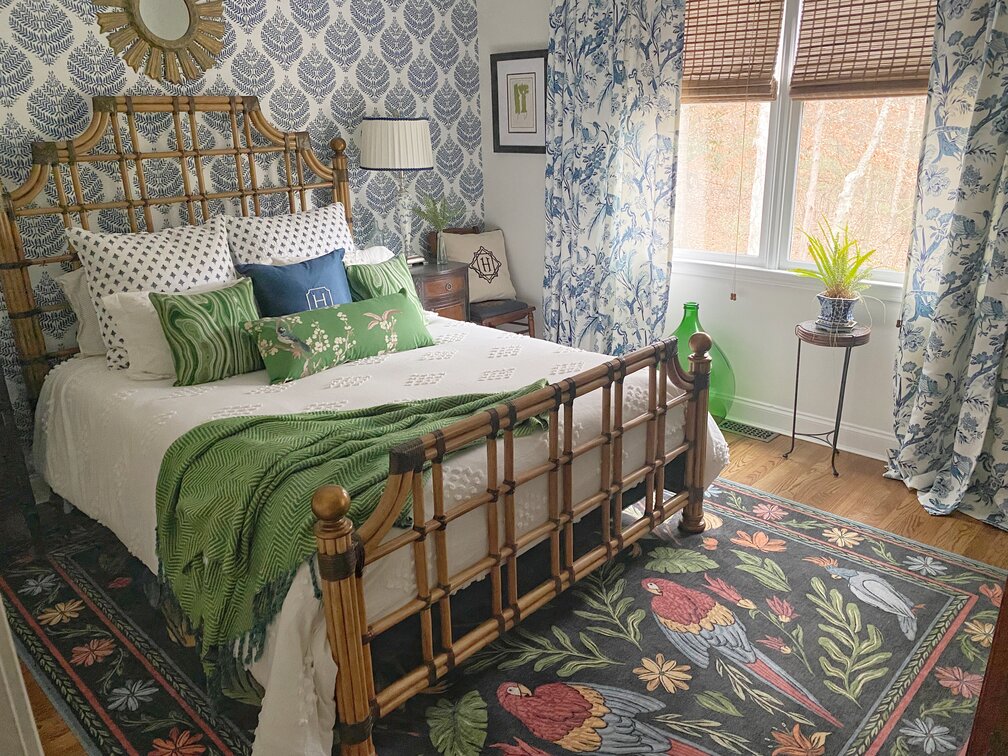
Embrace the beauty of bamboo in your interior spaces. Bamboo furniture and decor not only exude elegance but also carry a sustainability story. Crafted from a rapidly renewable resource, these pieces contribute to reducing deforestation while adding a touch of natural warmth to your home.
What are some creative ways to use bamboo in indoor decoration?
- A bamboo bookshelf makes a beautiful plant stand to display plants and photos
- Bamboo plant stands are organic and highlight those house plants really well
- Bamboo side tables are beautiful and like a work of art
- I have a new bamboo bed from Tommy Bahama in my guest room that I fell in love with after seeing it in a show house.
- Bamboo barstools add an organic feel to our counter in the kitchen.
- A bamboo-hanging full-length wall mirror is in our bedroom, and I love looking at it daily.
-Rhoda Vickers Hendrix at Southern Hospitality
Bamboo Textiles for Sustainable Fashion
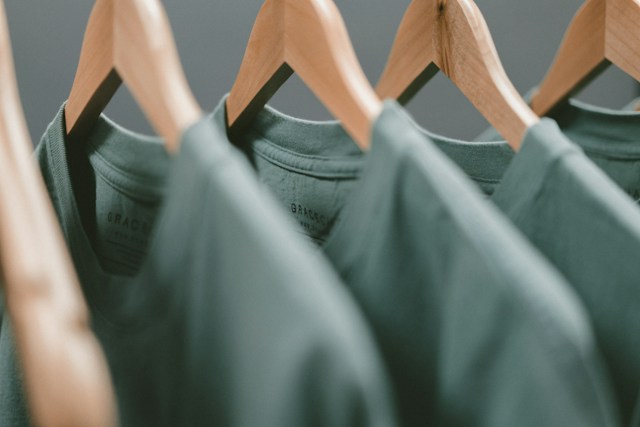
Venture beyond the home and into the realm of sustainable fashion as bamboo textiles redefine your wardrobe with a blend of comfort, style, and environmental mindfulness. Derived from the pulp of the bamboo plant, these textiles emerge as soft, breathable alternatives that elevate your fashion choices while remaining steadfast in their commitment to sustainability.
What are the benefits of bamboo textiles, and how do they compare to other fabrics?
Discover the exceptional advantages of bamboo fiber, a versatile material with many benefits. Bamboo clothing is considered an excellent alternative to cotton and polyester due to its soft feel and easy care and its sustainable and eco-friendly credentials.
The first noticeable quality of the bamboo fabric is its luxurious softness against the skin. Customers often become enthusiasts, asserting that once they experience the comfort of bamboo clothing, they cannot imagine wearing anything else. Bamboo clothing offers a soothing alternative, particularly for individuals with skin sensitivities like eczema and psoriasis, avoiding the irritation caused by other fabrics.
Breathability sets bamboo clothing apart, outperforming even cotton. Research indicates that bamboo garments breathe better and possess moisture-wicking and antibacterial properties. Picture slipping into bamboo socks and realizing you can enjoy enduring softness and comfort for days on end. Our bamboo pajamas, favored by many, redefine the sleepwear experience with a perfect blend of comfort and breathability.
Step into the great outdoors with confidence in bamboo clothing! Bamboo Body’s bamboo fabric is certified UPF 50+, certified by ARPANSA for outstanding sun protection. Bamboo’s natural thermo-regulating properties ensure comfort in various weather conditions, making bamboo sportswear and underwear wardrobe-essentials.
Bamboo clothing is ideal for layering and particularly suitable as travel clothing. Perfect for long-haul flights, bamboo fabric will keep you comfortable and fresh for your travel adventures.
Beyond being a fashion statement, bamboo clothing stands as an eco-friendly alternative to cotton and polyester. Bamboo, one of the world’s most renewable resources, grows rapidly without the need for pesticides or excessive water. Bamboo Body bamboo fiber holds the OEKO-Tek100 certification, signifying freedom from harmful chemicals and residues.
Embrace a wardrobe that combines style, comfort, and sustainability with bamboo fabric, where each piece reflects the soft touch, easy care, and eco-friendly ethos that make bamboo an ideal choice for those valuing luxury and environmental responsibility.
-Elouise Danby at Bamboo Body
What are the key sustainability benefits of bamboo clothing, and how does it compare to other eco-friendly fabrics?
As the CMO of our eco-conscious clothing brand at NOT LABELED, I’m proud to outline the sustainability highlights of our bamboo clothing line. Bamboo’s fast maturity, taking three to five years compared to hardwoods taking decades, allows sustainable harvesting. Bamboo regenerates from its roots without replanting, protecting soil quality and conserving resources.
- Renewable Resource: Bamboo grows incredibly fast and requires no harmful pesticides, and minimal water, setting a high bar for sustainability.
- Biodegradability: Our clothing is fully biodegradable, decomposing naturally without leaving pollutants.
- Carbon Efficiency: Bamboo absorbs more CO2 than equivalent plants, producing cleaner air.
- Comfort: It’s naturally moisture-wicking and thermally regulating, keeping wearers comfortable in various climates.
- Hypoallergenic: The natural softness means less processing and a hypoallergenic nature, friendly to sensitive skin.
- Responsible Farming: We source from farms that uphold biodiversity and avoid overharvesting.
Compared to other eco-fabrics:
- Organic Cotton: Bamboo is superior in water efficiency and vital in water-scarce regions.
- Hemp: Though sustainable, hemp can be coarser, while bamboo fabric offers a softer feel.
- Recycled Polyester: Unlike polyester, bamboo is biodegradable and doesn’t contribute to microplastic pollution.
- Tencel/Lyocell: Bamboo is comparably sustainable but has an edge due to its adaptability and less land-intensive cultivation.
Every piece of our clothing comes in 100% biodegradable packaging, ensuring a sustainable experience from product to package. Choosing our bamboo line supports a healthier planet.
-Sylvan Kills at Not Labeled
Tips for Seamless Integration
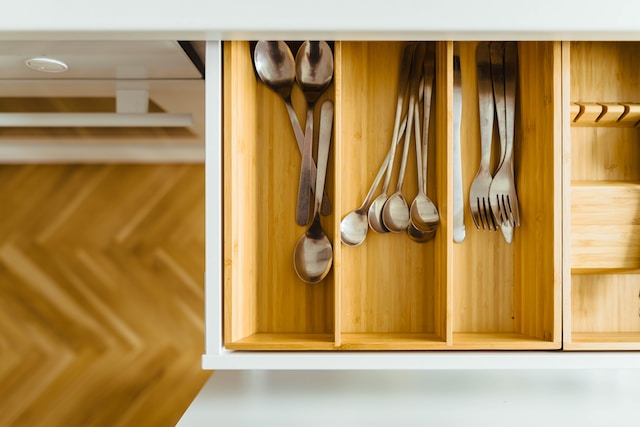
Integrating bamboo into our daily lives has become synonymous with conscientious living in a world where sustainability meets style. Consider gradually integrating bamboo, starting with small changes like kitchenware or decorative items. Engage in DIY projects that align with your interests, fostering a sense of accomplishment as you contribute to a more sustainable living space.
How can I incorporate bamboo into my daily routine, such as in my kitchen, bathroom, or bedroom?
As the founder of Bamboa, a bamboo home and lifestyle brand, I seamlessly incorporate bamboo items into my daily routine, enhancing my kitchen, bathroom, and bedroom experiences with sustainable and eco-friendly choices.
In the kitchen, I have replaced traditional cutting boards with durable bamboo cutting boards. They provide a smooth and reliable surface for food preparation while adding a touch of natural elegance to my kitchen decor. Bamboo utensils have replaced plastic ones, offering a lightweight and heat-resistant option for cooking and serving meals. I also use bamboo bowls for serving salads, fruits, and snacks, adding both functionality and aesthetic appeal. I rely on highly absorbent and compostable bamboo fiber dishcloths to wipe down surfaces.
In the bathroom, I have embraced the luxury of bamboo towels. They are soft, absorbent, and quick-drying, providing a spa-like experience after every shower. To reduce plastic waste, I have switched to bamboo toothbrushes, which are eco-friendly and compostable at the end of their lifespan. For makeup removal, I rely on gentle and reusable bamboo makeup removers, reducing both waste and irritation.
In my bedroom, I prioritize comfort and sustainability by using bamboo bedding. The soft and breathable bamboo sheets and pillowcases provide a restful night’s sleep while contributing to a more eco-conscious lifestyle. To block out light and promote deeper sleep, I rely on a lightweight bamboo sleep mask.
By seamlessly incorporating bamboo items into my daily routine, I enjoy their functional benefits and contribute to a more sustainable lifestyle. Bamboo’s rapid growth, minimal water requirements, and eco-friendly properties make it the perfect choice for my kitchen, bathroom, and bedroom needs. I take pride in supporting sustainable practices and reducing my environmental footprint with every use.
-Julia Washbourne at Bamboa Home
How can I incorporate bamboo into my daily routine, such as in my kitchen, bathroom, or bedroom?
Incorporating bamboo into your daily routine is a fantastic way to embrace sustainability and introduce eco-friendly elements. Here are some ideas on how you can integrate bamboo into your kitchen, bathroom, and bedroom:
Kitchen:
- Cutting Boards: Bamboo cutting boards are sturdy, hygienic, and gentle on knife blades, making them an ideal choice for meal preparation.
- Utensils: Bamboo utensils, like spatulas and spoons, are a sustainable alternative to plastic or metal ones.
- Dishware: Bamboo dishware, such as plates and bowls, is durable and aesthetically pleasing.
Bathroom:
- Toothbrush: Opt for a ‘The future is bamboo’ toothbrush, which is FSC & PETA certified with handles made from biodegradable materials.
- Reusable Makeup Removing Rounds: Look for ‘The future is bamboo’ Facial Rounds made with bamboo charcoal, which is more sustainable than single-use wipes and cotton rounds.
- Cotton Swabs: Bamboo Cotton Swabs are actually compostable! The future is bamboo has super soft, easy-to-use swabs in travel formats and family size.
Bedroom:
- Bedding: Bamboo sheets and pillowcases are soft, breathable, and hypoallergenic, providing a comfortable night’s sleep.
- Furniture: Bamboo furniture, such as bed frames and nightstands, brings a natural, elegant look to your bedroom.
- Closet Organizers: Bamboo hangers and closet organizers help keep your wardrobe neat and organized.
Incorporating bamboo into your daily routine contributes to a more sustainable lifestyle. Bamboo is a rapidly renewable, biodegradable resource, reducing your environmental footprint. Moreover, its natural beauty and versatility make it a great addition to any room in your home. Embracing bamboo benefits the planet and enhances the aesthetics and functionality of your living spaces.
-Naomi Berg at The Future is Bamboo
How can bamboo be integrated outdoors, and what benefits does it offer?
Palmex synthetic bamboo can be integrated into outdoor spaces in various ways:
- To create fences, trellises, or screens, adding an aesthetic appeal to a garden or landscape.
- As a roof covering for patios, decks, or pergolas to provide shade and a tropical ambiance.
- As decorative elements, such as in light fixtures, outdoor art installations, or as part of signage.
- As panels to create privacy screens or partitions in outdoor spaces.
- As walls around structures like cabanas.
- A post for umbrellas.
- As gutters to collect the rainwater.
- As an element for outdoor showers.
- To design outdoor or indoor furniture like chairs, tables, benches, or even a bed for a natural look with weather-resistant properties.
The sky is the limit to what can be done with Palmex Synthetic Bamboo, which offers several benefits, including:
- Durability: it’s highly durable and resistant to weather, rot, insects, and decay, making it ideal for outdoor use.
- Low maintenance: requires minimal upkeep compared to natural bamboo, as it doesn’t need staining, sealing, or regular treatments.
- Versatility: comes in different sizes and colors, allowing unlimited creation to fit different design needs and applications.
- Consistency: synthetic bamboo maintains its appearance and color over time without fading or warping due to exposure to sunlight or moisture.
- Environmentally friendly: it contributes to sustainability efforts by reducing the need for harvesting natural bamboo.
- Cost-effective: While initial costs might be higher, it can save money in the long run due to its longevity and low maintenance requirements compared to natural bamboo.
- Safety: Synthetic bamboo doesn’t splinter, making it safer for use in areas where people will be in contact with the material.
-Corinne Schevin at Palmex International
Everyday Bamboo Products

Elevate your daily routine with bamboo essentials. From cutting boards to reusable utensils, bamboo products offer functionality without sacrificing sustainability. Lightweight, durable, and biodegradable, these items empower you to make environmentally conscious choices in your everyday life.
What are some practical tips and ideas for incorporating bamboo into a sustainable lifestyle?
If ‘sustainable’ and ‘eco-friendly’ are key buzzwords in your daily life – Bamboo products should definitely have earned a place there as well.
Bamboo is a rapidly growing grass mostly known for its versatility and environmentally friendly properties. In addition to this, products made with bamboo are incredibly strong and durable. By ensuring it is responsibly sourced and produced ethically – utilizing bamboo products is an excellent addition to greener living. But in case you need a few tips and suggestions, here are some of our favorite bamboo products and why we love them.
Bamboo Charcoal: Bamboo charcoal is naturally porous and pulls moisture and odor from the surrounding air. Unlike the harsh scents and toxic chemicals found in candles and sprays meant to ‘mask’ odors, bamboo charcoal products eliminate must and odor naturally, offering a safer, non-toxic alternative to life’s stinky stuff.
Bamboo Furniture: Let’s just say this. Bamboo is so strong it will cut through concrete if grown near it. That is why furniture and homes are sustainably built from bamboo here and abroad. It is one of the most robust materials in nature, and because it grows so rapidly, it is considered a renewable resource.
Clothing and Bedding: Bamboo fiber is breathable, moisture-wicking, soft, and hypoallergenic. So whether you love it in your sportswear due to its antibacterial properties or your bedding to keep you cool and comfy – bamboo has you covered. Literally.
Utensils, straws, and toothbrushes: Durable. Lightweight. Eco-friendly. Reusable. Biodegradable – do we need to say more? We didn’t think so. So eat up! (then brush your teeth!)
By incorporating bamboo products into a sustainable lifestyle, you are clearly doing yourself and the planet a world of good! Not only are you contributing to environmental conservation and a smaller carbon footprint, but you are utilizing a renewable resource with many practical uses and benefits – you may forget it’s grass! Happy Bambooing!
-K.B. Lee at Ever Bamboo
What are the benefits of bamboo pillows?
Consistently good sleep is crucial for overall health, yet it eludes many, often due to less-than-ideal bedding choices. Some reasons why switching to bamboo pillows may be the solution for catching those elusive Z’s are:
Eco-friendly choice: Bamboo is a sustainable resource, growing rapidly with minimal environmental impact, It requires no pesticides and little water, making it a green option. Moreover, bamboo pillows are biodegradable, reducing waste when it’s time for replacement.
Universal comfort: Regardless of sleeping position—side, back, or stomach—bamboo pillows offer a supportive yet soft experience. They are adjustable, conforming to your head shape, which can alleviate neck and back discomfort. Many bamboo pillows, like those from Ethical Bedding, are even osteopath-approved.
Hypoallergenic benefits: Bamboo’s hypoallergenic nature makes it resistant to dust mites, pet dander, and mold, ideal for allergy sufferers. It’s an excellent material for creating an allergy-free bedroom environment, minimizing the risk of allergic reactions and respiratory irritations.
Hygiene and care: Bamboo has natural antimicrobial properties, meaning pillows made from this material stay cleaner for longer, providing a hygienic sleeping surface. They’re also low maintenance; requiring less frequent washing, they can be cleaned easily with eco-friendly detergent.
Breathability: For those who sleep hot, bamboo pillows are a blessing. The fabric’s breathability helps regulate temperature, providing a cool and comfortable night’s rest. This natural fabric’s moisture-wicking properties further contribute to a dry, pleasant sleep experience.
Durability and longevity: Beyond comfort, bamboo pillows are durable, often outlasting their cotton counterparts. This longevity makes them a cost-effective investment over time.
Safe and non-toxic: Free from harmful chemicals, bamboo pillows are not just comfortable but also safe for your skin and overall health. Ethical Bedding offers Oeko-Tex-certified bamboo fibers, ensuring that no substances will harm you or the environment.
While bamboo pillows might be slightly heavier and require some getting used to, and not all are machine washable, the pros far outweigh these minor cons. Their environmental benefits and the comfort and health advantages they offer make bamboo pillows an intelligent choice for anyone looking to improve their sleep quality.
-James Higgins at Ethical Bedding
What are the benefits of using bamboo pulp paper?
Bamboo pulp paper has several advantages, including:
- Environmental Friendliness: Bamboo is a renewable plant with rapid growth, low environmental impact, and excellent material properties. Its industrial and commercial value is increasingly recognized and accepted by people.
- Durability: Bamboo fibers are naturally strong, producing durable paper with good tear resistance.
- Softness: Bamboo pulp paper is often softer than hardwood pulp paper, making it suitable for products like tissues and wipes.
- Health Benefits: Bamboo fibers have natural antibacterial and antimicrobial properties, as bamboo contains a unique substance called “bamboo kun.”
- Comfort: Bamboo fibers are fine, and when observed under an electron microscope, they reveal multiple elliptical gaps in a hollow state. This enhances breathability, making bamboo pulp paper highly absorbent, often called the “breathing fiber queen.”
- Biodegradability: Bamboo paper can naturally decompose, reducing landfill waste.
- Energy Efficiency: Due to lower chemical requirements, the production process of bamboo pulp paper is more energy-efficient than traditional wood paper processes.
These characteristics make bamboo pulp paper an ideal alternative for many paper products, from packaging to personal care items.
-Allen Yi at SYWIPE
How do I care for and maintain bamboo sheets?
The best way to care for and maintain bamboo sheets is by washing them separately in your washing machine with cold water and a mild detergent. Do not use harsh chemicals, such as bleach, as that can weaken the delicate bamboo fibers over time. Washing your bamboo sheets in cold water will help maintain their softness for years. We recommend drying your bamboo sheets separately on low/medium heat to reduce the risk of snagging or pilling. Do not use dryer sheets, as that can leave a residue on the sheets, which can cause them to lose their temperature-regulating properties. We do, however, recommend wool dryer balls as they help to dry your sheets while also softening at the same time without using any chemicals.
-Mandy Miller at Simply Organic Bamboo
What are the benefits of using Reusable Bamboo Towels compared to traditional paper towels and synthetic cleaning cloths/wipes?
Our range of sustainable cleaning cloths, wipes, and sprays has one undefeated champion: our Reusable Bamboo Towels.
Many people consume piles and piles of single-use traditional paper towels daily. If you stop and think about the process each of these towels has gone through to get to your kitchen only to be used for 5 seconds, it almost begs the question, how is that even allowed? Luckily many consumers are becoming aware of this and moving to alternative reusable products.
But what makes Reusable Bamboo Towels so much better?
Reusable bamboo towels can be washed up to 80 times in your washing machine and used anywhere to clean your silverware, kitchen counter, and restroom, and even wipe down dirty pet paws. When you want to dispose of it, it naturally composts.
Bamboo is made of incredibly strong fiber, and the products have undefeated absorbency abilities. Wiping up dirt, spills, oil, food even kids’ faces after a meal can all be done with one bamboo towel (perhaps not in the order just listed).
Each bamboo towel admittedly also goes through a process to be created, just like a paper towel. However, as it’s reusable, you don’t use as much and make less of a footprint. And no trees suffer in the process.
We also see many consumers using synthetic cloths and wipes for cleaning. Most people don’t know that synthetic cloths and wipes leave little microplastics behind. We either consume these small plastic particles or wash them into our waterways and, ultimately, the ocean.
So for the safety of our family and also the marine life, we need to look at alternatives for synthetics too. Bamboo is the ideal fiber for cleaning and, in most situations, will be superior to any synthetic counterpart.
One thing we all have to keep in mind is to only use bamboo products that come from sustainably forested bamboo. That way, you’re certain you’re not supporting the destruction of life-giving native forestry for excessive bamboo farming but instead supporting a life cycle that can sustain itself.
-Stine Smith at Good Change
Beyond its structural strength and pest resistance in construction, bamboo’s role as carbon sequestered marks it as a frontline warrior in combating climate change. Navigating bamboo’s landscape requires embracing challenges like invasive species and ethical sourcing. Staying informed and choosing products from reputable sources aligns our bamboo choices with responsible practices, fortifying our commitment to sustainable living.
Embrace bamboo as your sustainable living companion, enriching your immediate surroundings and contributing to a lasting positive impact on the environment. The journey toward a greener home begins with bamboo’s subtle yet transformative power.
